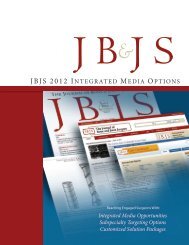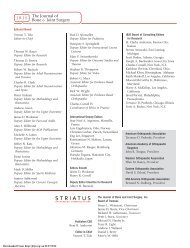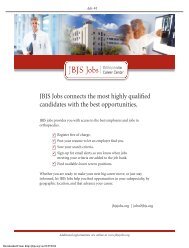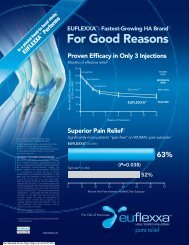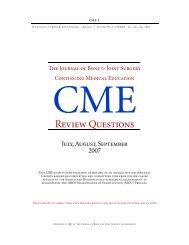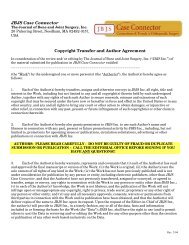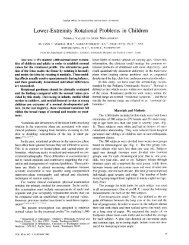Front Matter - The Journal of Bone & Joint Surgery
Front Matter - The Journal of Bone & Joint Surgery
Front Matter - The Journal of Bone & Joint Surgery
You also want an ePaper? Increase the reach of your titles
YUMPU automatically turns print PDFs into web optimized ePapers that Google loves.
(V2 ampule) intramuscularly, 15 minutes be-<br />
fore anesthesia for children and 5 mg. (1<br />
ampule) for adults.” In only one patient did<br />
bleeding occur. Three others showed red blood<br />
from the nose and mouth. <strong>The</strong>se patients<br />
“were then given 5 mg. intramuscularly, with<br />
prompt and complete control. We have also<br />
noticed that bleeding stopped more promptly<br />
on the operating table.”<br />
This is a 1% incidence <strong>of</strong> postoperative<br />
bleeding using Adrenosem Salicylate preop-<br />
eratively, compared to an incidence <strong>of</strong> 10%<br />
postoperative bleeding in all cases taken from<br />
previous records, without Adrenosem Salicyl-<br />
ate medication.<br />
Peele reports on the use <strong>of</strong> Adrenosem Sali-<br />
cylate in treating 178 patients with 24 different<br />
conditions.5 <strong>The</strong> drug was first used to control<br />
postoperative hemorrhage from the adenoid<br />
region. He adds: “<strong>The</strong> results were so dramatic<br />
that since that date [1953] Adrenosem Salicyl-<br />
ate has been used postoperatively to reduce<br />
bleeding from all otolaryngologic and broncho-<br />
csophagolic procedures, to treat postoperative<br />
hemorrhage from the tonsil and adenoid re-<br />
gions, and to treat selected cases <strong>of</strong> epistaxis.”<br />
<strong>The</strong> effectiveness <strong>of</strong> Adrenosem Salicylate<br />
in controlling bleeding and oozing in 330 pa-<br />
tients is reviewed by Bacala.6 “Our experience<br />
<strong>of</strong> the effect <strong>of</strong> carbazochrome salicylate on<br />
317 surgical indications and 13 obstetrico-<br />
gynecological conditions, has l)een therapeuti-<br />
cally encouraging and successful for the control<br />
<strong>of</strong> capillary bleeding. Foremost among the<br />
cases studied were 223 tonsillectomies definitely<br />
benefited by this metabolic hemostat, making<br />
a diminution <strong>of</strong> the control incidence <strong>of</strong> post-<br />
tonsillectomy bleeding <strong>of</strong> 19.8% down to 7%.<br />
It has also been found useful in gastro-intestinal<br />
bleeding, cataract extraction, epistaxis, mci-<br />
sional seepage, trans-urethral prostatectomy,<br />
menometrorrhagias, cervical ooze, antepartum<br />
and postpartum bleeding, threatened abor-<br />
tion, and prevention <strong>of</strong> capillary hemorrhages<br />
during hedulin or dicumerol therapy.”<br />
Side Effects<br />
All investigators concur that, at recom-<br />
mended dosage levels, Adrenosem Salicylate is<br />
free from toxic effects. No cumulative effects<br />
attributable to the drug have been reported.<br />
<strong>The</strong> only side reaction noted has been a<br />
transient stinging sensation in the area <strong>of</strong> in-<br />
jection when Adrenosem Salicylate is used<br />
intramuscularly. As one investigator com-<br />
ments: “<strong>The</strong> brief discomfort which attends<br />
the injection <strong>of</strong> Adrenosem into the gluteal<br />
region has not been a significant problem in<br />
children or adults as originally anticipated.”5<br />
Indications<br />
Idiopathic pu rpura, retinal hemorrhage,<br />
familial telangiectasia, epistads, hemoptysis,<br />
hematuria.<br />
Postoperative bleeding associated with:<br />
tonsillectomy, adenoidectomy and<br />
nasopharynx surgery;<br />
prostatic and bladder surgery;<br />
uterine bleeding;<br />
postpartum hemorrhage;<br />
dental surgery;<br />
chest surgery and chronic pulmonary bleeding.<br />
Dosage<br />
For recommended dosage schedulcs, please<br />
send for detailed literature.<br />
Supplied<br />
Ampuls: 5 mg., I cc. (package <strong>of</strong> 5).<br />
Tablets: I mg. S.C. Orange, bottles <strong>of</strong> 50.<br />
Tablets: 2.5 mg. S.C. Yellow, bottles <strong>of</strong> 50.<br />
Syrup: 2.5 mg. per 5 cc. (1 tsp.), 4 ounce<br />
References<br />
bottles.<br />
1. Roskam, J. and Derouaux, G.: Arch. <strong>of</strong> Intern.<br />
Pharmacodynamie 71:389 (1945).<br />
2. Roskam,J.: Arrest <strong>of</strong> Bleeding, Charles C. Thomas,<br />
Springfield, Ill. 1954.<br />
3. Sherber, Daniel A.: <strong>The</strong> Control <strong>of</strong> Bleeding, Am.<br />
J. Surg. 86:331 (1953).<br />
4. Owings, Capers B.: <strong>The</strong> Control <strong>of</strong> Postoperative<br />
Bleeding with Adrenosem, Laryngoscope, 55:21<br />
(Jan., 1955).<br />
5. Peele, J.C.: Adrenosem in the Control <strong>of</strong> Hemorrhage<br />
from the Nose and Throat, A.M.A. Arch. <strong>of</strong><br />
Otolaryng. 61 :450 (April, 1955).<br />
6. Bacala, J.C.: <strong>The</strong> Use <strong>of</strong> the Metabolic Hemostat,<br />
Adrenosem Salicylate. To be published.<br />
7. Riddle, A.C.Jr.: Adrenoscm Salicylate: A Systemic<br />
Hemostat, Oral Surg., Oral Med., Oral Path.<br />
6:617 (June, 1955).<br />
8. Fulton, M.D., Dept. <strong>of</strong> Biology, Boston University:<br />
Personal Communication.<br />
THE S. E. MASSENGILL COMPANY . BRISTOL, TENNESSEE<br />
NEW YORK KANSAS CITY SAN FRANCISCO



